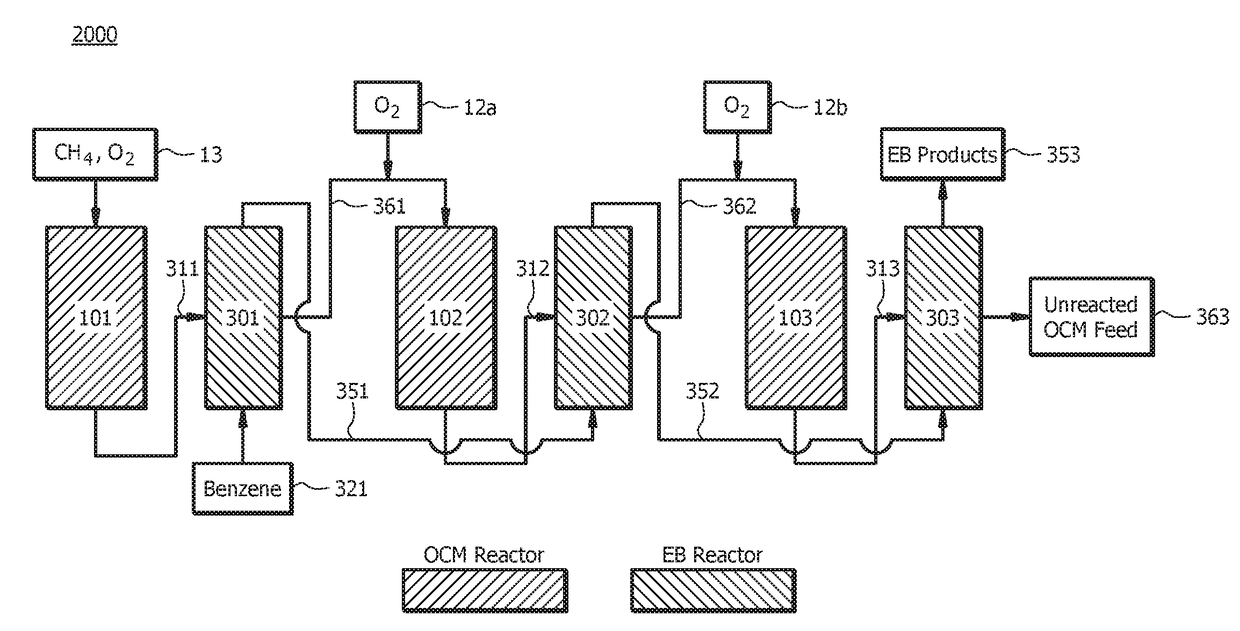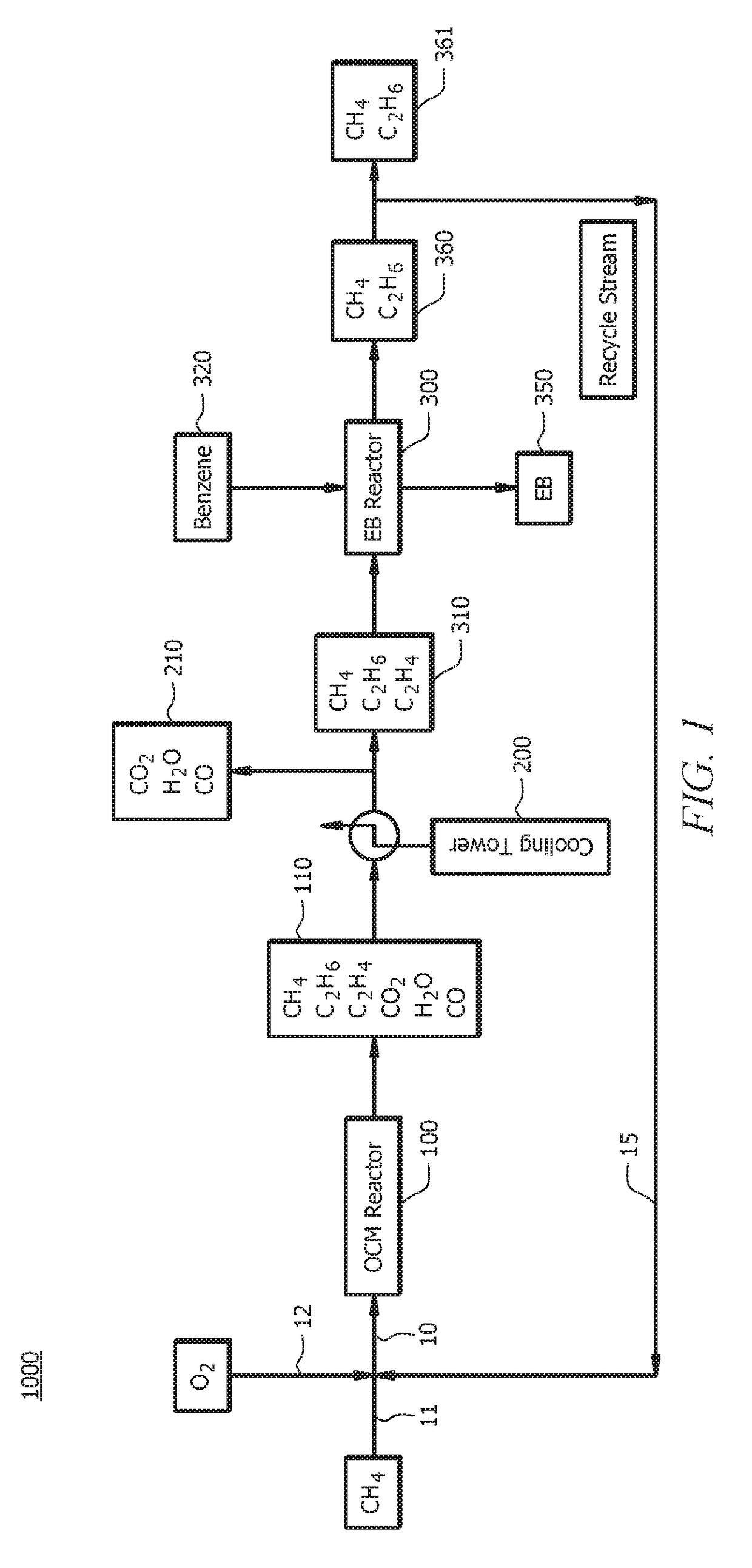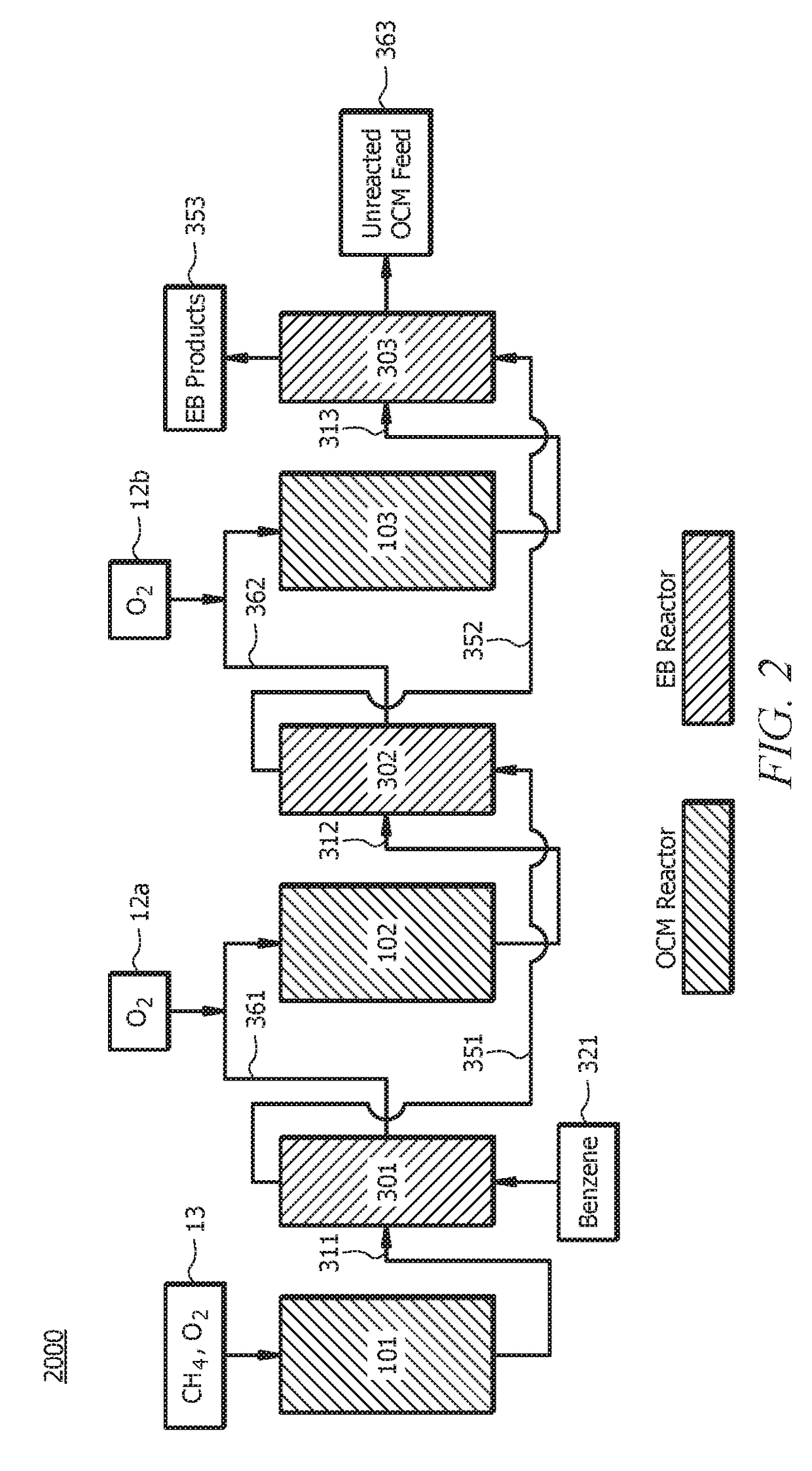Ethylbenzene Production with Ethylene from Oxidative Coupling of Methane
a technology of ethylbenzene and methane, which is applied in the direction of hydrocarbon preparation, molecular sieve catalyst, catalyst, etc., can solve the problems of high separation cost, high process cost, and substantial reduction of ethylene production when compared with carbon monoxide and carbon dioxide production
- Summary
- Abstract
- Description
- Claims
- Application Information
AI Technical Summary
Benefits of technology
Problems solved by technology
Method used
Image
Examples
first embodiment
[0090]A first embodiment, which is a method for producing ethylbenzene (EB) comprising (a) introducing a first oxidative coupling of methane (OCM) reactant mixture to a first OCM reactor, wherein the first OCM reactant mixture comprises methane (CH4) and oxygen (O2); (b) allowing at least a portion of the first OCM reactant mixture to react via an OCM reaction to form a first OCM product mixture, wherein the first OCM product mixture comprises ethylene (C2H4), ethane (C2H6), water, carbon monoxide (CO), carbon dioxide (CO2) and unreacted methane; (c) separating components of the first OCM product mixture, wherein separating components comprises removing at least a portion of the water and optionally at least a portion of the CO and / or CO2 from the first OCM product mixture to yield a first EB reactant mixture, and wherein the first EB reactant mixture comprises C2H4, C2H6, unreacted methane, and optionally CO and / or CO2; (d) introducing benzene and at least a portion of the first EB...
seventh embodiment
[0116]A twenty-seventh embodiment, which is a method for producing ethylbenzene (EB) comprising (a) introducing an oxidative coupling of methane (OCM) reactant mixture to an OCM reactor, wherein the OCM reactant mixture comprises methane (CH4) and oxygen (O2); (b) allowing at least a portion of the OCM reactant mixture to react via an OCM reaction to form an OCM product mixture, wherein the OCM product mixture comprises ethylene (C2H4), ethane (C2H6), water, carbon monoxide (CO), carbon dioxide (CO2) and unreacted methane; (c) separating at least a portion of the water and optionally at least a portion of the CO and / or CO2 from the OCM product mixture to yield an EB reactant mixture, wherein the EB reactant mixture comprises C2H4, C2H6, unreacted methane, and optionally CO and / or CO2; (d) introducing benzene and at least a portion of the EB reactant mixture to an EB reactor, wherein the at least a portion of the EB reactant mixture is pressurized prior to introducing to the EB react...
third embodiment
[0122]A thirty-third embodiment, which is a method for producing ethylbenzene (EB) comprising (a) introducing an oxidative coupling of methane (OCM) reactant mixture to an OCM reactor, wherein the OCM reactant mixture comprises methane (CH4) and oxygen (O2); (b) allowing at least a portion of the OCM reactant mixture to react via an OCM reaction to form an OCM product mixture, wherein the OCM product mixture comprises ethylene (C2H4), ethane (C2H6), water, carbon monoxide (CO), carbon dioxide (CO2) and unreacted methane; (c) separating components of the OCM product mixture, wherein separating components comprises removing at least a portion of the water and optionally at least a portion of the CO and / or CO2 from the OCM product mixture to yield an EB reactant mixture, wherein the EB reactant mixture comprises C2H4, C2H6, unreacted methane, and optionally CO and / or CO2, and wherein separating components of the OCM product mixture excludes cryogenic distillation; (d) introducing benze...
PUM
| Property | Measurement | Unit |
|---|---|---|
| Temperature | aaaaa | aaaaa |
| Temperature | aaaaa | aaaaa |
| Temperature | aaaaa | aaaaa |
Abstract
Description
Claims
Application Information
 Login to View More
Login to View More - R&D
- Intellectual Property
- Life Sciences
- Materials
- Tech Scout
- Unparalleled Data Quality
- Higher Quality Content
- 60% Fewer Hallucinations
Browse by: Latest US Patents, China's latest patents, Technical Efficacy Thesaurus, Application Domain, Technology Topic, Popular Technical Reports.
© 2025 PatSnap. All rights reserved.Legal|Privacy policy|Modern Slavery Act Transparency Statement|Sitemap|About US| Contact US: help@patsnap.com



